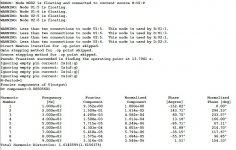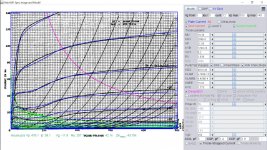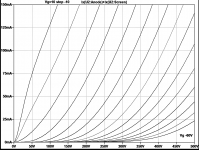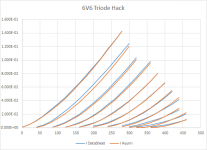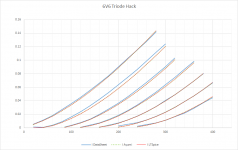Does anyone have a 5687 or 6900 model for TINA?
Can you convert a PSpice or LTspice model to TINA? If yes, then there are a few good 5687 models to choose from. I don't know of any 6900 models.
Here's the Ayumi 5687 model (I think for PSpice):
Code:
*
* Generic triode model: 5687
* Copyright 2003--2008 by Ayumi Nakabayashi, All rights reserved.
* Version 3.10, Generated on Sat Mar 8 22:42:01 2008
* Plate
* | Grid
* | | Cathode
* | | |
.SUBCKT 5687 A G K
BGG GG 0 V=V(G,K)+0.35624804
BM1 M1 0 V=(0.022532918*(URAMP(V(A,K))+1e-10))^-0.73087992
BM2 M2 0 V=(0.67238043*(URAMP(V(GG)+URAMP(V(A,K))/14.539598)+1e-10))^2.2308799
BP P 0 V=0.0048744976*(URAMP(V(GG)+URAMP(V(A,K))/21.624065)+1e-10)^1.5
BIK IK 0 V=U(V(GG))*V(P)+(1-U(V(GG)))*0.0028821468*V(M1)*V(M2)
BIG IG 0 V=0.0024372488*URAMP(V(G,K))^1.5*(URAMP(V(G,K))/(URAMP(V(A,K))+URAMP(V(G,K)))*1.2+0.4)
BIAK A K I=URAMP(V(IK,IG)-URAMP(V(IK,IG)-(0.0027792585*URAMP(V(A,K))^1.5)))+1e-10*V(A,K)
BIGK G K I=V(IG)
* CAPS
CGA G A 4p
CGK G K 4p
CAK A K 0.6p
.ENDS5687 work for 6900
The 6900 has a bigger heater more current . 5687 will work for most part . 6900 do have a design error that make them age in the box not running . not worth the high price they are getting . I have had 6 of them for about 20 years four of the 6 have aged to used up levels in the box two are still great . This I hope helps. 😱
The 6900 has a bigger heater more current . 5687 will work for most part . 6900 do have a design error that make them age in the box not running . not worth the high price they are getting . I have had 6 of them for about 20 years four of the 6 have aged to used up levels in the box two are still great . This I hope helps. 😱
I have a friend who has a bunch of 6900 made not too long ago from the tube factory in CA. Actually, he bought the whole factory and has it in storage right now. 😎
5965 model on #1449 has errors
I tried to use 5965 model posted on #1449. Can someone take a look and see what's wrong with the model? LTspice said the nodes 5 and 6 have no connection. I tried a few guesses to correct the error and each time got additional error messages.
I tried to use 5965 model posted on #1449. Can someone take a look and see what's wrong with the model? LTspice said the nodes 5 and 6 have no connection. I tried a few guesses to correct the error and each time got additional error messages.
There is no problem with model. Have a look in Spice err log, see what is the problem. Try one or all the following options, see it runs successfully.
.option noopiter
.options GminSteps=0
.options SrcSteps=0
.option noopiter
.options GminSteps=0
.options SrcSteps=0
I have set up a SRPP circuit to check the distortion level. The schematic is attached. Below is the error and warning messages from LTspice with the 5965-brm model:
ERROR: Node N002 is floating and connected to current source B:U1😛
WARNING: Node U1:5 is floating.
WARNING: Node U1:6 is floating.
WARNING: Node U2:5 is floating.
WARNING: Node U2:6 is floating.
WARNING: Less than two connections to node U1:5. This node is used by R:U1:1.
WARNING: Less than two connections to node U1:6. This node is used by D:U1:3.
WARNING: Less than two connections to node U2:5. This node is used by R:U2:1.
WARNING: Less than two connections to node U2:6. This node is used by D:U2:3.
I can add a line to eliminate the floating error. But I am not sure that is the right way to do it. I am also not very comfortable with warning messages.
ERROR: Node N002 is floating and connected to current source B:U1😛
WARNING: Node U1:5 is floating.
WARNING: Node U1:6 is floating.
WARNING: Node U2:5 is floating.
WARNING: Node U2:6 is floating.
WARNING: Less than two connections to node U1:5. This node is used by R:U1:1.
WARNING: Less than two connections to node U1:6. This node is used by D:U1:3.
WARNING: Less than two connections to node U2:5. This node is used by R:U2:1.
WARNING: Less than two connections to node U2:6. This node is used by D:U2:3.
I can add a line to eliminate the floating error. But I am not sure that is the right way to do it. I am also not very comfortable with warning messages.
Attachments
I used PIN name instead of PIN number seem to have solve the problem, thank you for bringing up the matter.
Code:
* 5965-brm LTSpice model
.subckt 5965-brm P G K
+ params: ccg=3.8p cgp=3p ccp=0.5p rgi=1000
Bp P K I=(0.03112183049m)*uramp(V(P,K)*ln(1.0+(-0.01696282954)+exp((0.4797489307)+(0.4797489307)*( (191.7722271)+(-4570.034317m)*V(G,K))*V(G,K)/sqrt((38.68534305)**2+(V(P,K)-(20.90183057))**2)))/(0.4797489307))**(1.20117455)
Rpk P K 1g
Cgk G K {ccg}
Cgp G P {cgp}
Cpk P K {ccp}
Rgk G K {rgi}
d3 G K dx
.model dx d(is=1n rs=2k cjo=1pf tt=1n N=1.5)
.ends 5965-brm
Last edited:
I wish him the best of luck with that we can use a Tube factory in the USA. 🙂I have a friend who has a bunch of 6900 made not too long ago from the tube factory in CA. Actually, he bought the whole factory and has it in storage right now. 😎
6P1P_EB model does not work in circuit
Hi Koonw,
The 6P1P_EB model does not work on circuits I would like to use. I have tried a few different designs and all have some problems. I attached two of the simple schematics that I used to test the model. Can you run them and find out what are the issues with the model?
Hi Koonw,
The 6P1P_EB model does not work on circuits I would like to use. I have tried a few different designs and all have some problems. I attached two of the simple schematics that I used to test the model. Can you run them and find out what are the issues with the model?
Attachments
Use only this option for both schematic, this option works immediately for SE schematic, in PP schematic added series resistance of more than 15 Ohms in L1 and L2 solved the problem.
.option noopiter
.option noopiter
Another super long shot ... I managed to get ahold of some 6DY7 tubes. I might be the only person in the world interested in a model, but is there any chance there's one out there?
6DY7 model:
Code:
* Created on 08/25/2020 15:14 using paint_kip.jar
* [url=http://www.dmitrynizh.com/tubeparams_image.htm]Model Paint Tools: Trace Tube Parameters over Plate Curves, Interactively[/url]
* Plate Curves image file: 6DY7.png
* Data source link: <plate curves URL>
*----------------------------------------------------------------------------------
.SUBCKT 6DY7 P G2 G K ; LTSpice tetrode.asy pinout
* .SUBCKT 6DY7 P G K G2 ; Koren Pentode Pspice pinout
+ PARAMS: MU=19.39 KG1=2098.4 KP=21.93 KVB=1290.24 VCT=0.2 EX=1.636 KG2=4815.46 KNEE=15.62 KVC=1.773
+ KLAM=9.766E-12 KLAMG=4.469E-4 KD=0.02489 KC=0.02446 KR1=0.001825 KR2=0.04759 KVBG=0.00974 KB1=2.703 KB2=1.628 KB3=2.584 KB4=0.2532 KVBGI=0.003321 KNK=-4.226E-13 KNG=0.008856 KNPL=15.42 KNSL=13.39 KNPR=118.19 KNSR=34.32
+ CCG=3P CGP=1.4P CCP=1.9P VGOFF=-1.5 IGA=0.001 IGB=0.489 IGC=11.6 IGEX=1.6
* Vp_MAX=500 Ip_MAX=140 Vg_step=5 Vg_start=0 Vg_count=12
* X_MIN=52 Y_MIN=34 X_SIZE=799 Y_SIZE=561 FSZ_X=1296 FSZ_Y=736 XYGrid=false
* Rp=1400 Vg_ac=20 P_max=15 Vg_qui=-27.5 Vp_qui=300
* showLoadLine=n showIp=y isDHP=n isPP=n isAsymPP=n isUL=n showDissipLimit=y
* showIg1=y isInputSnapped=y addLocalNFB=n
* XYProjections=n harmonicPlot=y dissipPlot=n
* UL=0.43 EG2=250 gridLevel2=y addKink=y isTanhKnee=n advSigmoid=y
*----------------------------------------------------------------------------------
RE1 7 0 1G ; DUMMY SO NODE 7 HAS 2 CONNECTIONS
E1 7 0 VALUE= ; E1 BREAKS UP LONG EQUATION FOR G1.
+{V(G2,K)/KP*LOG(1+EXP((1/MU+(VCT+V(G,K))/SQRT(KVB+V(G2,K)*V(G2,K)))*KP))}
RE2 6 0 1G ; DUMMY SO NODE 6 HAS 2 CONNECTIONS
E2 6 0 VALUE={(PWR(V(7),EX)+PWRS(V(7),EX))} ; Kg1 times KIT current
E4 8 0 VALUE={V(P,K)/KNEE/(KVBGI+V(6)*KVBG)}
E5 81 0 VALUE={PWR(V(8),KB1)}
E6 82 0 VALUE={PWR(V(8),KB2)}
E7 83 0 VALUE={PWR(V(8),KB3)}
E8 9 0 VALUE={PWR(1-EXP(-V(81)*(KC+KR1*V(82))/(KD+KR2*V(83))),KB4)*1.5708}
RE4 8 0 1
RE5 81 0 1
RE6 82 0 1
RE7 83 0 1
RE8 9 0 1
RE21 21 0 1
E21 21 0 VALUE={V(6)/KG1*V(9)} ; Ip with knee but no slope and no kink
RE22 22 0 1 ; E22: kink curr deviation for plate
E22 22 0 VALUE={V(21)*LIMIT(KNK-V(G,K)*KNG,0,0.3)*(-ATAN((V(P,K)-KNPL)/KNSL)+ATAN((V(P,K)-KNPR)/KNSR))}
G1 P K VALUE={V(21)*(1+KLAMG*V(P,K))+KLAM*V(P,K) + V(22)}
G2 G2 K VALUE={V(6)/KG2*(KVC-V(9))/(1+KLAMG*V(P,K)) - V(22)}
RCP P K 1G ; FOR CONVERGENCE
C1 K G {CCG} ; CATHODE-GRID 1
C2 G P {CGP} ; GRID 1-PLATE
C3 K P {CCP} ; CATHODE-PLATE
RE23 G 0 1G
GG G K VALUE={(IGA+IGB/(IGC+V(P,K)))*(MU/KG1)*
+(PWR(V(G,K)-VGOFF,IGEX)+PWRS(V(G,K)-VGOFF,IGEX))}
.ENDS
*$Attachments
EL84 LTSpice Model
I see that EL84 is not in the list. Any suggestions where to get the EL84 model?
Regards
Mike
Courtesy of jazbo8 the Ayumi SPICE model library:
Files included, copyrighted material, if you distribute these files make sure that the first three lines are not removed.
PSpice Models => View attachment 638558
A time-saver, the file below contains all the Ayumi SPICE models that are compatible with LTspice - manual editing of the files is no longer required!
LTspice Models => View attachment 689353 (New 06/29/2018)
I see that EL84 is not in the list. Any suggestions where to get the EL84 model?
Regards
Mike
Use 6BQ5. That's the US name for the EL84.
--
Thanks.
(should have double-checked the alternate name before asking).
This is owesome by the way. Thanks diyAudio community and the contributor (Ayumi) for these libraries.
It is almost impossible to do any design work without proper sims.
(I am a noob, just starting now with diy-ing valve amps.)
Thanks again,
Regards
I spent some time massaging the Ayumi triode model, some of the nested parentheses are 7 deep. What spits out is an excel spreadsheet with 11 variables and several conditionals. I don't know the optimization program Ayumi was using, nor the data sheet from which he he derived the curves (I used the RCA data sheet from pocnet) but since most of the data sets were artfully drawn with a "french curve" it looks pretty good given the variability of tubes and data derived 60 years ago:
Attachments
Hi jackinnj
It seems that we had the same idea at the same time - I'm working also on such an excel sheet for my triode model! 😉
It was quite tricky because the equations for Ia and Ig depends on each other (no problem for LTspice, but a challenge for excel)
How ever, it looks quite promissing now.
I hope to finish the beta Version in some days...
all the best, Adrian
It seems that we had the same idea at the same time - I'm working also on such an excel sheet for my triode model! 😉
It was quite tricky because the equations for Ia and Ig depends on each other (no problem for LTspice, but a challenge for excel)
How ever, it looks quite promissing now.
I hope to finish the beta Version in some days...
all the best, Adrian
Last edited:
It seems that we had the same idea at the same time
If you use the full precision (8 significant digits in the constants) the Excel model and the LTSpice simulation match up very closely. The model author may have used a different data sheet or optimization program as we see a bit of variance from the GE datasheet (it's GE, not RCA).
At least when Excel and LTSpice line up there's more confidence you're going in the correct direction.
The PNG I posted before rounded the constants to 4 significant places.
Attachments
- Home
- Amplifiers
- Tubes / Valves
- Vacuum Tube SPICE Models

